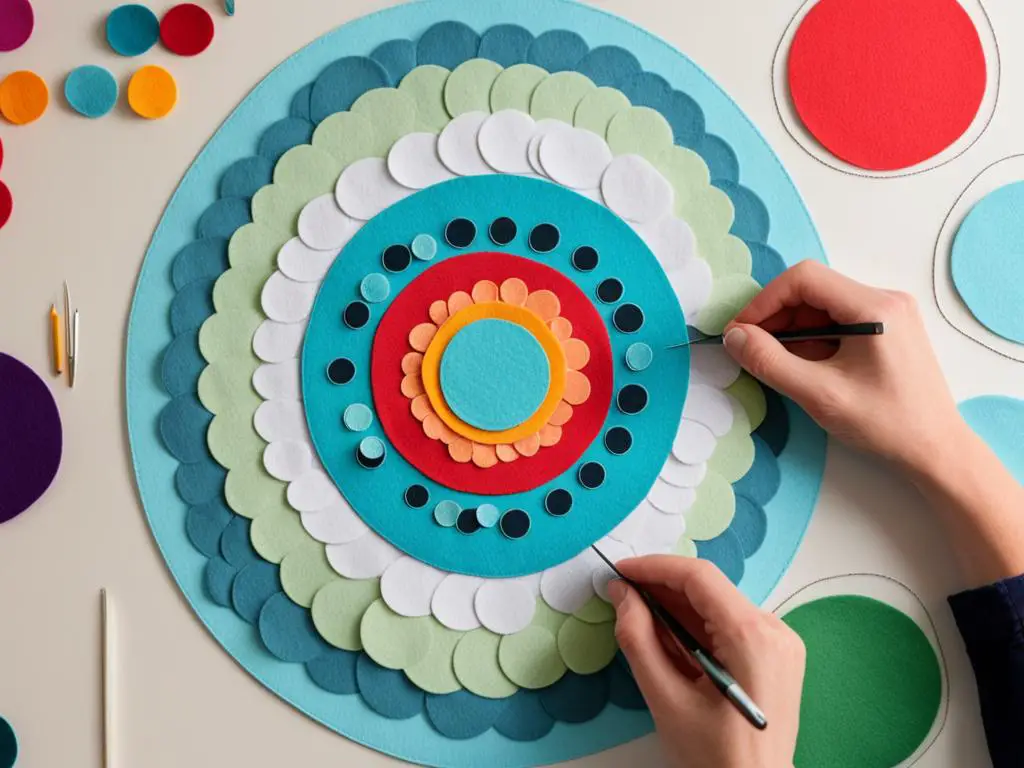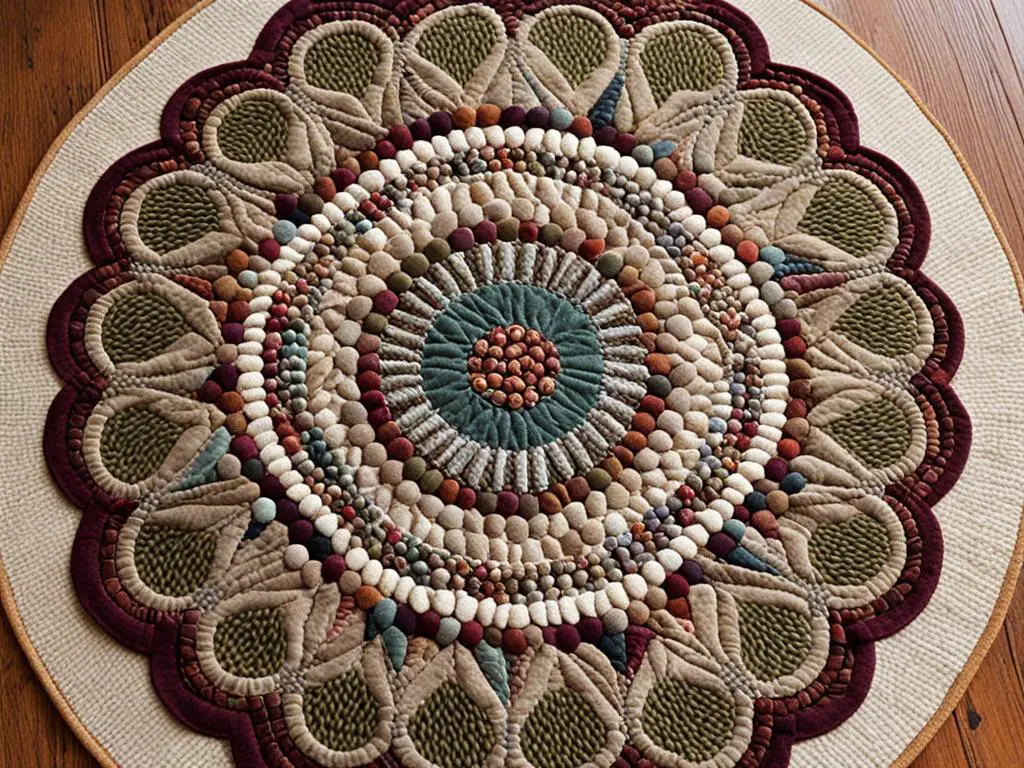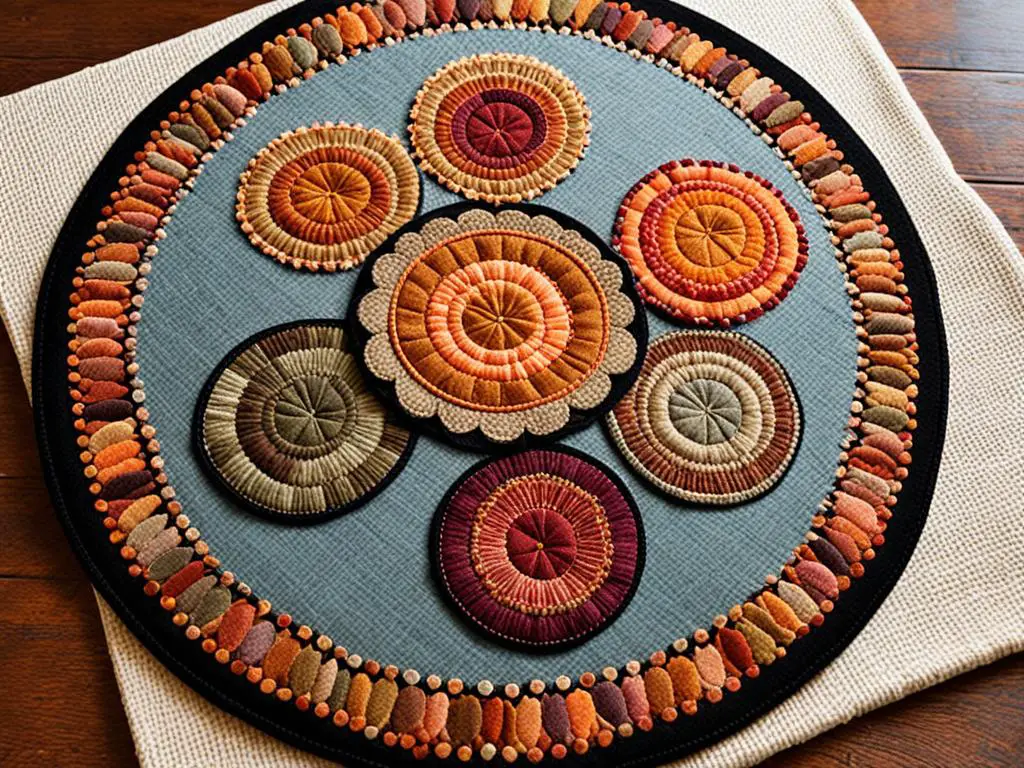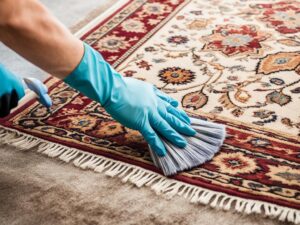Penny rugs may sound like something you’d find under your feet, but they are actually decorative mats for tables and furniture. These unique pieces of craftsmanship are made by stitching together various sized wool circles using a blanket stitch.
Some penny rugs feature appliquéd designs such as farmhouses, animals, and flowers, adding an extra touch of charm to their appearance. Not only are they aesthetically pleasing, but penny rugs also have a rich history that dates back to the 1800s.
The craft of making penny rugs originated during the Civil War when resourceful homemakers would repurpose scraps of wool or felt from old clothing. They created these mats to be durable and practical, with the ability to withstand a rug beater and even wipe dirt off muddy boots. Some penny rugs were even sewn with pennies inserted into the bottom to weigh them down flat.
Key Takeaways:
- Penny rugs are decorative mats made of stitched wool circles.
- They often feature appliquéd designs and are durable and practical.
- The craft originated during the Civil War, with homemakers repurposing scraps of wool or felt.
- Penny rugs were designed to withstand a rug beater and even wipe dirt off muddy boots.
- Some penny rugs were sewn with pennies inserted into the bottom to weigh them down flat.
The History Behind Penny Rugs
Penny rugs have a fascinating history that dates back to the 1800s, during the time of the Civil War. These decorative mats, although not actual rugs, were crafted by resourceful homemakers using scraps of wool or felt. By cutting these scraps into circles of various sizes, they created intricate designs that would adorn tables and furniture in homes.
In their quest for accuracy, crafters used pennies as templates to measure the top layer of circles, thus giving the rugs their charming name. As penny rugs gained popularity, crafters began experimenting with different decorative edgings, such as scallops, teardrops, and tongues. This attention to detail added an extra touch of elegance to the traditional craft.
Originally, penny rugs were not just decorative pieces but were also highly practical and durable. They were used to cover beds, tables, and mantles, providing both protection and style to these household items. It is fascinating to note that penny rugs were even designed to withstand a rug beater and could be used to wipe off dirt from muddy boots, showcasing their functionality in addition to their beauty.
Over time, penny rugs evolved to include appliquéd designs that depicted scenes from everyday life, animals, and blooming flowers. These designs not only added artistic value but also captured stories and reflected the rich heritage and traditions of the craft.
As the history of penny rugs unfolded, they became an iconic symbol of American craftmanship and continue to be celebrated to this day. Their legacy as practical yet aesthetically pleasing creations has made them a cherished part of our heritage.
How to Make Penny Rugs
Making penny rugs is a creative and enjoyable craft that allows you to design your own unique pieces. Follow these steps to create your very own penny rug:
- Gather the necessary materials:
- Scraps of wool or felt
- Sewing needle
- Scissors
- Thread
For the backing of your penny rug, you can repurpose various materials such as burlap, heavy canvas, or even old blue jeans. Select a material that suits your preferred style and the intended use of your penny rug.
There are numerous penny rug patterns available to guide you in creating your design. Browse through different patterns and choose one that inspires you.
Using the scraps of wool or felt, cut out circles of different sizes. These circles will be the basis for your penny rug design.
Using a blanket stitch, sew the circles together to form the desired layout of your penny rug. This stitch not only secures the circles but also adds a decorative touch.
If you desire additional embellishments, consider adding decorative edging to your penny rug. You can experiment with scallops, teardrops, or tongues to achieve the desired aesthetic.

Once you have completed the steps, you will have your very own handcrafted penny rug. Penny rugs can be used in various ways, such as coasters, candle mats, or even larger centerpieces for tables and mantles. Let your creativity guide you in incorporating penny rugs into your home decor.
Penny Rug Materials
When making penny rugs, it’s important to have the right materials. Here are the essential items you’ll need:
| Materials |
|---|
| Scraps of wool or felt |
| Sewing needle |
| Scissors |
| Thread |
| Backing material (e.g., burlap, heavy canvas, old blue jeans) |
By having these materials ready, you’ll be well-prepared to start creating your own stunning penny rugs.
Why Include Penny Rugs in Your History Lessons?
Penny rugs are not only a creative and fun craft but also a great way to incorporate history into your lessons. By making penny rugs, children can learn about the history of penny rugs and the time period it originated from, such as the Civil War era.
Penny rugs provide hands-on experience in sewing and following step-by-step directions, allowing students to develop their fine motor skills and attention to detail. They serve as tangible reminders of historical knowledge and can be displayed as decorative pieces or used practically. Including penny rugs in history lessons allows children to connect with the past and appreciate the penny rug craftsmanship of earlier generations.
Integrating penny rugs into history lessons allows for a multidimensional approach to learning, combining arts and crafts with historical research. Students can explore the materials, designs, and techniques used in creating penny rugs, enhancing their understanding of the cultural and artistic aspects of the time period.
Moreover, penny rugs offer an opportunity for students to discuss the social and economic context in which penny rugs were created. They can examine the availability of materials, the significance of recycling fabric scraps, and the practical uses of penny rugs in households during that era.
Hands-On Learning with Penny Rugs
Penny rugs provide an engaging and interactive way for students to learn about history. Here are some benefits of including penny rugs in your history lessons:
- Historical Connection: Penny rugs offer a tangible link to the past, allowing students to connect with the lives and creativity of earlier generations.
- Enhanced Creativity: Making penny rugs encourages students to think creatively and design their own unique patterns, fostering artistic expression.
- Practical Skills: Sewing penny rugs develops hand-eye coordination, fine motor skills, and the ability to follow step-by-step instructions.
- Historical Research: Students can delve into the history of penny rugs and explore primary sources, such as historical photographs and literature, to deepen their understanding of the craft’s significance.
- Critical Thinking: Analyzing the cultural, social, and economic aspects of penny rugs encourages students to think critically about the historical context in which they were created.
Incorporating penny rugs into history lessons not only makes the learning process more engaging but also fosters a deeper appreciation for the rich history and penny rug craftsmanship of the past.
The Charm and Value of Penny Rugs
Penny rugs hold a unique charm that captivates crafters and collectors alike. Despite their name, penny rugs can be worth much more than their humble title suggests. They are a testament to the artistry and craftsmanship of the past, created using scraps of wool or felt that were carefully stitched together.
Penny rugs often feature intricate designs and details that tell stories of the time period they were made in. These beautiful works of art showcase the creativity and skill of the individuals who crafted them. Whether it’s a simple circle pattern or a more elaborate appliquéd scene, each penny rug carries a piece of history within its stitches.
Antique penny rugs are highly sought after by collectors today. These pieces provide a tangible connection to the past and offer a glimpse into the creativity and resourcefulness of earlier generations. Their value extends beyond monetary worth, as they embody the traditions and craftsmanship of a bygone era.

Collecting penny rugs allows individuals to appreciate the artistry and legacy of this unique craft. Each rug tells a story and adds character to any space. Displayed on a table or hung on a wall, penny rugs bring warmth and nostalgia to a room.
“Penny rugs are more than just decorative pieces; they are a testament to the dedication and creativity of the crafters who came before us. Each stitch represents a piece of history and a labor of love.” – Mary Thompson, Antique Penny Rug Collector
The allure of penny rugs lies not only in their historical significance but also in their versatility. They can be used as centerpieces, table runners, or even framed as wall art. Their enduring charm and ability to add a touch of vintage elegance make them a beloved choice among collectors and home decorators alike.
Key Points:
- Penny rugs are crafted from scraps of wool or felt, showcasing the resourcefulness of earlier generations.
- Intricate designs and attention to detail make each penny rug a unique piece of art.
- Antique penny rugs hold historical and sentimental value, offering a window into the past.
- Collecting penny rugs allows appreciation for the craftsmanship and heritage they represent.
- Penny rugs can be displayed as centerpieces, table runners, or framed wall art.
Penny Rug Preservation and Collecting
Preserving and collecting penny rugs is a way to honor the craft and its heritage. Antique penny rugs should be handled with care to protect their delicate stitching and fabrics. When collecting penny rugs, look for authentic pieces that show signs of use and wear, indicating their age and history. Authentic penny rugs may include hidden pennies that were sewn into the bottom for added weight. They can be found in various sizes and designs, from small coasters to larger rugs meant for tables or beds. Collectors often look for specific features such as decorative edging, appliquéd designs, and unique color combinations.
Collecting penny rugs allows enthusiasts to immerse themselves in the rich history and craftsmanship of this traditional art form. These rugs tell a story of utility and creativity, showcasing the resourcefulness of generations past. By preserving and cherishing these textiles, collectors ensure that the legacy of penny rug craftsmanship remains intact for future generations to appreciate.
Preserving Antique Penny Rugs
Preserving antique penny rugs requires careful attention to ensure their longevity.
- Handle with care: Avoid excessive folding, bending, or pulling on the fabric to prevent damage to the stitches and wool. When storing, roll the rug gently instead of folding it.
- Keep away from sunlight: Exposure to direct sunlight can fade the colors of the rug over time. Display or store your penny rugs in areas away from windows or use UV-protective window coverings.
- Use acid-free materials: Acidic materials, such as cardboard or tissue paper, can cause discoloration and deterioration. Instead, opt for acid-free archival tissue paper or storage boxes.
- Maintain stable humidity: Fluctuations in humidity can affect the condition of the rug. Aim for a stable humidity level of around 40-55%. Consider using a dehumidifier or humidifier to regulate moisture levels if necessary.
- Keep away from pests: Insects and rodents can damage the fabric of the rug. Store in a clean, pest-free area, and periodically check for signs of infestation.
Collecting Antique Penny Rugs
When starting a collection of antique penny rugs, it’s essential to educate yourself about the different styles, designs, and techniques prevalent during the time period the rugs were made. This knowledge will help you make informed decisions and identify authentic pieces.
Here are some factors to consider when collecting:
- Condition: Look for penny rugs that show signs of use and wear, as these indicate their age and history. Some fraying or minor damage can add character and authenticity to the rug.
- Design: Consider your personal preferences and the rug’s overall aesthetic appeal. Look for patterns, motifs, and colors that draw you in and reflect the craftsmanship of the era.
- Authenticity: Authentic penny rugs often have hidden pennies sewn into the bottom for added weight. Check for these unique features to ensure the rug’s genuineness.
- Provenance: If possible, learn about the rug’s history and previous owners. Rugs with documented provenance can add value and interest to your collection.
To give you an idea of the beauty and variety of antique penny rugs, here is an example of different designs and color combinations:
| Design | Color Combination |
|---|---|
| Red, green, yellow | |
| Blue, white, gray | |
| Brown, orange, beige |
Collecting antique penny rugs allows you to appreciate the artistry, craftsmanship, and history they represent. Each rug holds a unique story, from the materials used to the hands that meticulously stitched it together. By becoming a custodian of these treasures, you contribute to the preservation of this time-honored tradition and ensure that the legacy of penny rug craftsmanship lives on.
Conclusion
Penny rugs are a fascinating craft that holds a special place in American craftsmanship and heritage. Dating back to the 1800s, these decorative mats were originally created using scraps of wool or felt stitched together. While not traditional rugs, penny rugs feature various designs, including circles and appliquéd shapes. They are both aesthetically pleasing and practical, with the ability to withstand wear and tear.
Creating penny rugs provides a hands-on learning experience, allowing crafters to connect with history. Through the use of different materials, patterns, and techniques, individuals can explore their creativity and produce unique designs. Additionally, incorporating penny rugs into history lessons can offer a tangible link to the past, giving children an opportunity to learn about the artistry and traditions of earlier generations.
Collecting and preserving antique penny rugs is a way to honor the craftsmanship of the past. These unique pieces showcase the intricacy and creativity of bygone eras, telling stories through their designs and color combinations. As sought-after collectibles, antique penny rugs hold both charm and value. Whether displayed as decorative pieces or used practically, they provide a glimpse into the rich history and traditions associated with this distinctive American craft.



